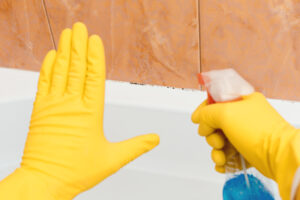
The grooves surrounding your tub and shower are a frequent location for mold because they collect water. However, mold can develop in your bathroom regardless of the conditions, and in some instances, it can be avoided by keeping up with plumbing repairs.
This article discusses three plumbing issues that might lead to mold growth in your bathroom and solutions.
- A Leaky Drain Beneath The Bathroom Sink
- A Shower Head Or Faucet That Is Dripping Water
- Toilet Water Seeping Out
A leak might not be noticed for a long time if an enclosed vanity hides the drain under your sink. Another issue is a loose connection in the trap, which develops a tiny leak every time you use the sink.
Since the sink only leaks when you use it, there isn’t a continual flow of water to cause a noticeable large puddle. Instead, the floor underneath or the vanity’s wood will absorb the water and remain damp. This causes the wood under the sink to rot and raises the humidity level in the space.
You might not see anything if you don’t frequently check inside the vanity or if it is stuffed with grooming products or jugs of detergent. The vanity’s interior or the wall behind it could develop mold growth. While minor mildew in your bathroom is occasionally expected, mold may develop inaccessibly if you notice it frequently.
The issue might be resolved by tightening the trap connection, but if a hole in the drain is to blame, you’ll need a plumber to address it immediately to prevent major water and mold damage to the floor and walls.
Dripping faucets are an unpleasant plumbing issue since they waste water and can also be noisy. Even while drops from your sink or shower don’t result in water damage, they can nevertheless increase the humidity in the space and promote mold growth.
Mold can develop anywhere when the humidity is high, including on the walls and ceiling. Mold may even grow between the walls of the shower enclosure if the dripping shower wets the rear of it. You might also require plumbing repairs and professional mold removal if that occurs.
Dripping faucets need to be fixed as soon as possible. One additional advantage of controlling humidity in your bathroom is that it deters roaches and other humidity-loving pests from taking up residence there.
Even your toilet might develop leaks. It might lead to the wall behind the developing toilet mold. If you can locate the leak’s source, a broken toilet seal on the floor, a break in porcelain, or a water supply line.
Problems with high humidity might also result from condensation on the tank’s side. You’ll probably need to install a new toilet if water is dripping from a little crack. Your plumber can advise installing a valve in the supply line that permits hot water to mix in if the issue is condensation.
The temperature difference that causes condensation on the tank is decreased. Have a plumber look at the area around the toilet if you notice any small water puddles. It will need to be replaced if the floor beneath your toilet is left damp for an extended time.
Symptoms Related To Mold
The symptoms of allergies, including watery eyes, runny noses, sneezing, itching, coughing, wheezing, difficulty breathing, headaches, and weariness can be brought on by exposure to many mold spores. A person’s sensitivity may rise with repeated contact with mold, leading to increasingly severe allergic reactions.
Call The Experts
Maintaining good bathroom plumbing will help you avoid mold, water damage, and bug issues. Make an appointment with Top Tier Plumbing and Rooter if your faucets or toilets need repair. If necessary, we’ll replace outdated fixtures, mend leaky pipes, or take other steps to keep your bathroom dry.
Call (951) 475-6521 and speak to one of our plumbing experts today!

